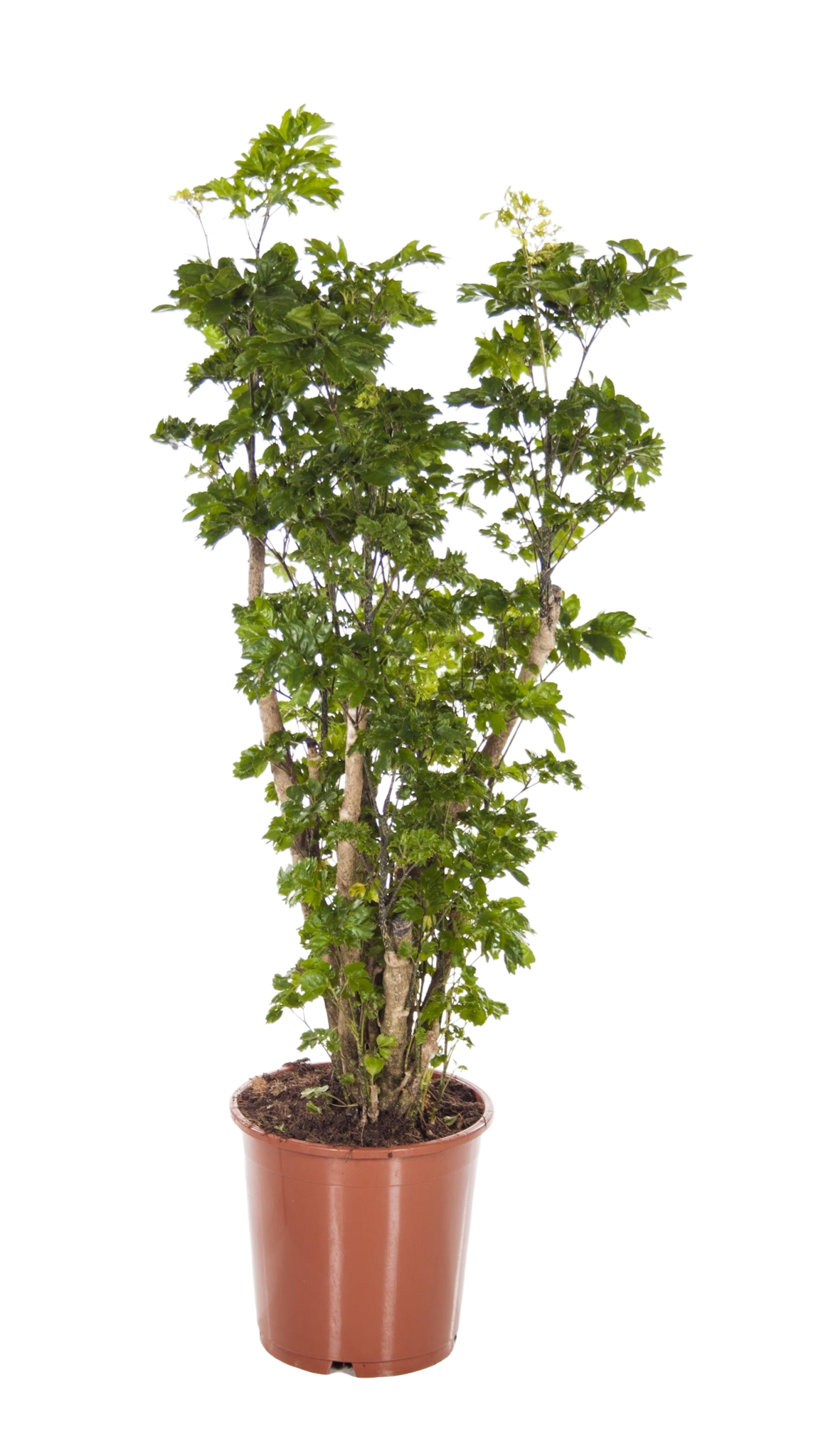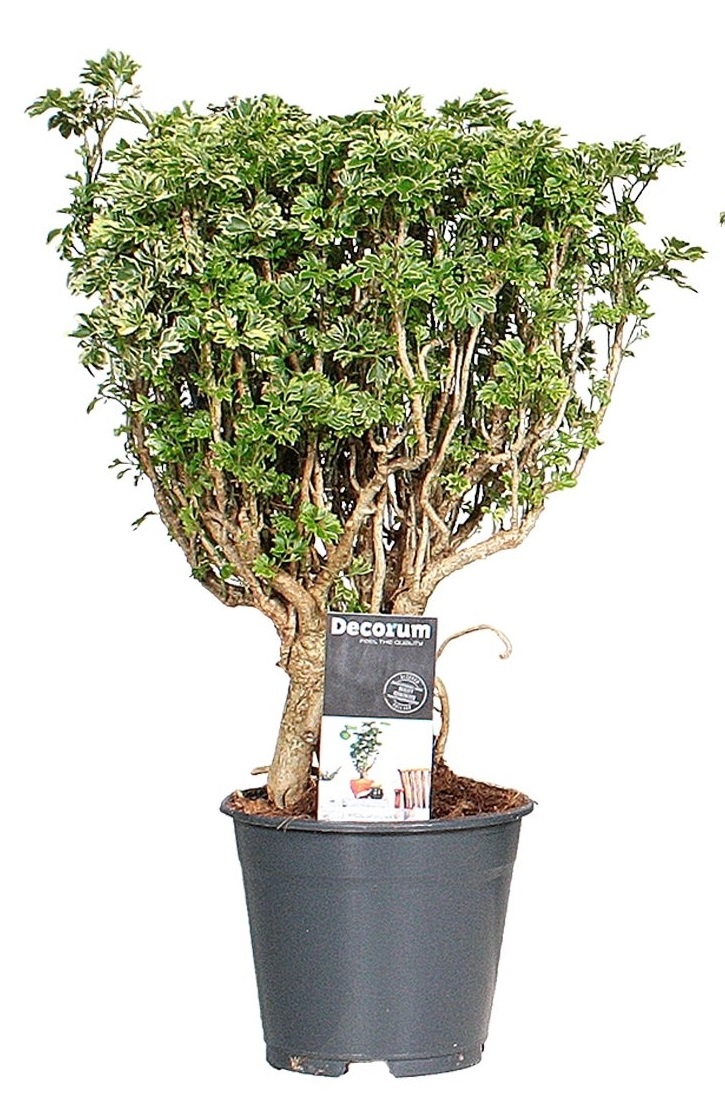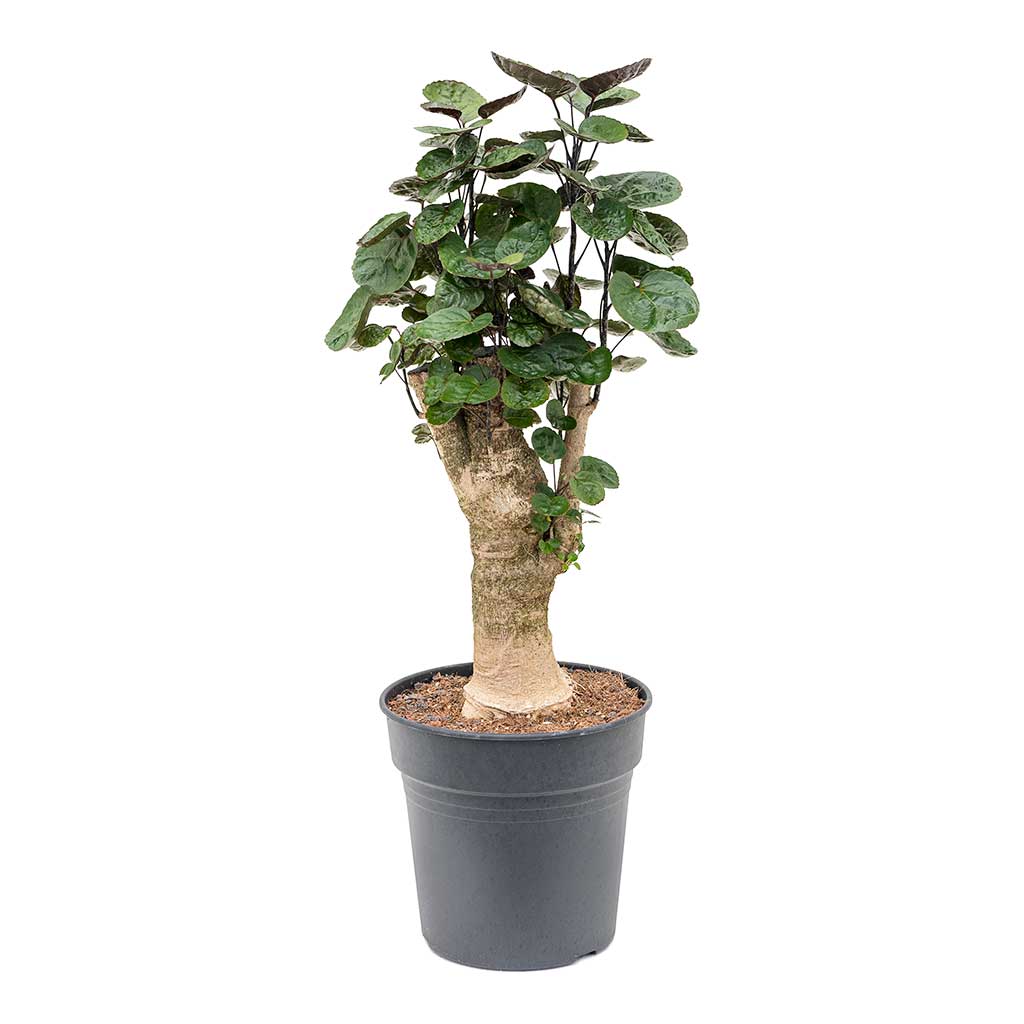
The Polyscias is a collection of large houseplants, native to Africa and Asia. The plant gets its name from a compound of the two Greek words “Poly” (many) and “Scias” (shade). In its original habitat, therefore, the Polyscias provides much needed shade. Incidentally, these plants are also called Aralia.As houseplants, they are popular because they are large and full plants. At the same time, they are not susceptible to diseases and quite easy to care for. How to care for Polyscias, tips and a solution to common problems you can read here.
Table of Contents
Polyscias care
Habitat and light
Good to know: The Polyscias likes sun! So give this plant a spot where it gets a few hours of direct sunlight a day. A place with little light is less suitable for this plant. Too little sun causes all kinds of problems. At first you will notice yellow leaves, but also leaf loss and limited growth are symptoms.
The Polyscias looks tough, but it can also be quite a diva when it comes to care. For example, it does not like to change its location. If you do, it can lose leaves. Sometimes you can’t avoid moving the plant, for example when buying it or during a move. Do not be alarmed if the Polyscias drops its leaves afterwards. There are other houseplants that have a tough appearance and can take a beating at the same time. If you are looking for something like this, check out the sturdy Yucca or the very strong Sanseveria.
Humidity
Another point of attention for the location is the humidity. This is already quite low in our homes, but when the heater is turned on it gets even lower. This causes all kinds of problems, the best known of which is that the leaves of the Polyscias get brown edges. So don’t put these plants near a radiator.
Apart from the location you can influence the humidity in other ways. A common method is to mist the leaves with a plant sprayer. If you do this daily, or at least several times a week, you mimic that high humidity. This will prevent brown edges or completely brown leaves on the Polyscias.
You can also choose to put several plants of tropical origin together. These plants all evaporate moisture, but by putting them together you create a micro-climate, so to speak. Between these plants the humidity is high and all plants, including the Polyscias, benefit from this. Many houseplants have tropical origins that you might not have expected. Consider, for example, the Philodendron, the Calathea and the Strelitzia.
Watering the Polyscias
How often do you water your Polyscias? The important thing is that the soil is never soaking wet, but also never completely dry out. If the soil is too wet, the plant will get yellow leaves and may even die from this eventually. If the soil is too dry, you will see a drooping plant, brown leaves and loss of foliage. So, how do you tackle it?
The correct method is to stick a finger in the potting soil and see if any soil sticks to it. If no soil sticks to it, the soil is dry enough to water. If soil sticks to it, the soil is still too wet. How much water do you give the Polyscias? So much that the plant needs water about twice a week. That way the soil never stays very wet, and it never dries out completely.
The right temperature
The minimum temperature for the Polyscias is 12 ℃. Then we really speak of the minimum. Rather, this plant has higher temperatures. In general, the normal room temperature is good, but avoid strong fluctuations in temperature. Think of drafts, an open window (in winter) or the air flow of an air conditioner. These temperature shocks can cause leaf loss in the Polyscias. You see the same thing with the popular houseplant Dracaena.
Pruning Polyscias
You can prune the Polyscias if you feel the plant is getting too tall. Often you buy this plant already quite large and branched, so it is quite possible that at some point you will want to put the pruning shears into it. Another reason to prune is to get a fuller plant. Pruning creates more shoots, so you can prune, but you must do it properly:
- Always use properly sharp secateurs. This prevents unsightly pruning wounds.
- Also, the pruning shears must have been disinfected. You will create wounds on the Polyscias and thus reduce the risk of infection.
- Pruning is best done in the fall. Then the plant is beautifully open and the little sunlight in winter can reach all parts of the plant.
- Prune each branch back by a few centimeters, until the desired appearance is achieved.
- You can also shorten the main stem. Preferably do this in the spring, when the plant enters the growth phase and can recover well from the intervention.
Pot and repot
Repotting is necessary after you have bought the Polyscias. The pot in which the plant is placed is almost always too small. In addition, it is necessary to repot the plant every two years. By then the roots have used up the available space and the Polyscias is too tight in the pot. Space in the pot is necessary because this way there is more room for soil, which can retain moisture. A lack of space in the pot usually results in a slack hanging Polyscias.
You are completely free in the choice of a flower pot, only 2 things are important. First, the new pot should be about a quarter larger than the old one. This way the Polyscias will have enough room to continue growing. In addition, there should be holes in the bottom of the pot. Aren’t there any? Then drill them yourself. Do this carefully, because a stone pot can easily break.
The holes are important to allow excess water to drain away. If the holes are not there, all the water will remain around the roots. This causes root rot. At first, this is not visible from above, but eventually it manifests itself in yellow leaves which then fall off. If you do not solve the root rot for a long time the Polyscias will die.
Which potting soil for the Polyscias?
Normal potting soil for houseplants is suitable for the Polyscias. Always use fresh potting soil when repotting the plant.
Nutrition for the Polyscias
In the spring and summer the Polyscias are in the growth phase. You can see this by the many new shoots and leaves that the plant makes. In this period there is also a need for extra nutrition. Give an organic nutrition for houseplants
If you have just repotted your Polyscias and added fresh soil, wait a little longer before adding nutrition. New potting soil always contains nutrition as well. Only when this is finished you can start giving plant nutrition. If you do this earlier, there will be a surplus of nutrition and you will damage the roots.
Polyscias species
In the last categorization it was established that there are 116 different species of Polyscias. The vast majority of these species still grow in their natural habitat. Only a few of them are known to us as houseplants. The most important Polyscias species as houseplants are:
- Polyscias Balfouriana
- Polyscias Ming
- Polyscias Fabian
- Polyscias Roble
- Polyscias Parsley bonsai
- Polyscias Lemon
Buy Polyscias
Would you like to buy one of these Polyscias? For such a large houseplant, it is smart to look at a specialized (web) store. Many of these web stores offer their products on Bol.com. Use the button below to go to the current offer:
Frequently asked questions and problems
Is the Polyscias toxic to pets?
As far as we know, this plant is not toxic to pets. So you can feel free to put a Polyscias down if you have cats, dogs, birds or other pets.
Polyscias lose leaves
If the Polyscias loses a leaf once in a while, this is not a problem. With large amounts of leaf loss, when the plant becomes barren, you do need to take action. The main causes of leaf loss are: a too dark location (Polyscias love sun!), too dry air, excess water and too low temperature. For all of these, you can read about the proper approach at the top of this page.
Help, my Polyscias stinks!
If your Polyscias stinks it is a signal that there are pests, such as lice or mites, on the plant. The smell is a defense mechanism of this plant. So check carefully for aphids, spider mites, mealy bugs or other critters on the leaves. These are usually near young leaves, near the stem.
Polyscias hang limp
Slack leaves on this plant usually mean one of two causes: too much or too little water. Make sure the soil is always slightly moist, but never soaking wet. At the same time, the soil should never dry out completely, or the plant will start to droop.
There are drops on the leaves
This may look strange, but it is quite normal. This is a process called guttation. The plant actually sweats out the water that the roots cannot get rid of. This also happens with other tropical plants such as Alocasia and Banana plants.

How fast does the Polyscias grow? That depends very much on the care. The better you do this, the faster the plant grows. The plant can then grow about 8 inches per year. Eventually, the Polyscias will be about 2 meters high and 70 centimeters in circumference. The exact dimensions, by the way, vary from species to species.
Can the Polyscias flower?
The flowers of this plant are beautiful, but as an indoor plant you will unfortunately not often see them. The conditions here are not sufficient for this plant to bloom.

| Botanical name | Polyscias |
| Also known as | Aralia |
| Original habitat | Africa and Asia |
| Number of known species | 116 |
| Standing | Sunny |
| Water requirements | Do not allow soil to dry out |
